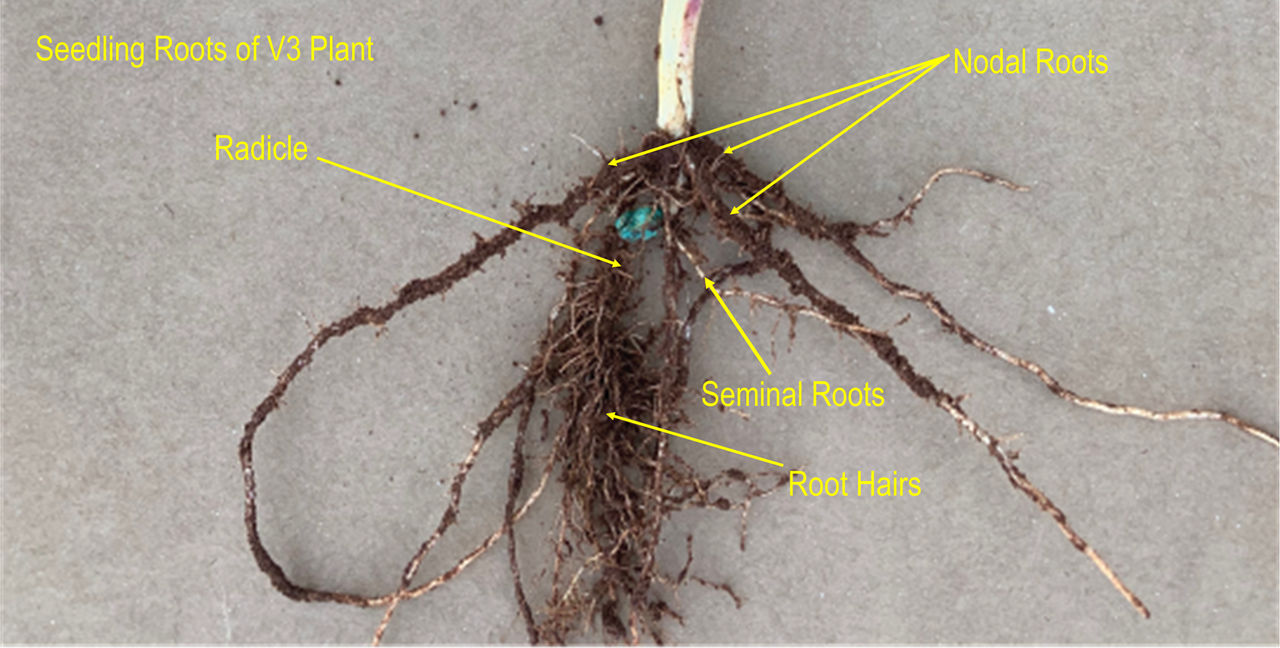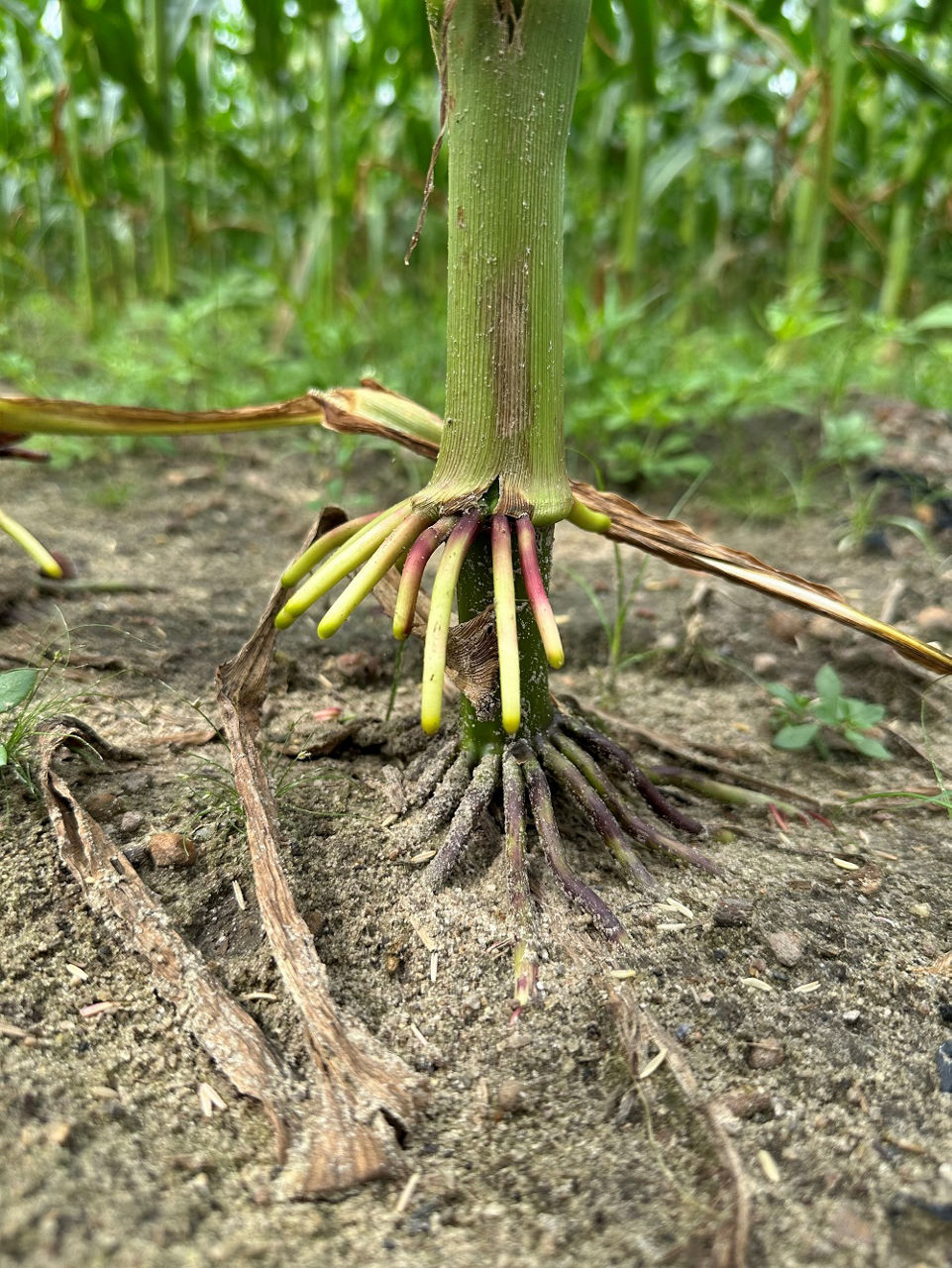Corn Brace Roots and Overall, Root Function
July 17, 2024
A healthy root system is essential for corn growth and optimal yields. A well-established root system enables the corn plant to utilize water and nutrients more efficiently enabling proper development and helps to anchor the plant, making it less susceptible to lodging. Corn has three stages of root development during its lifecycle: seminal roots develop at germination and emergence; nodal roots develop during the vegetive growth stage; and brace roots develop at or around flowering.
Seminal Roots (Figure 1)
The seminal root system originates within the seed embryo and is composed of the radicle and seminal roots. The radicle root emerges through the tip end of the seed coat first and elongates in that direction regardless of seed orientation. Lateral seminal roots emerge second and elongate toward the dent end of the kernel. You may think that the roots are growing “up” or sideways, but they soon respond to gravity and elongate downward. The primary function of the seminal root system is to sustain seedling development through water uptake. However, the main food source at this stage is starch from the kernel.1
Damage to the seminal root system can stunt seedling development, delay emergence, cause leafing out underground, or even kernel death. Imbibitional chilling, where the seed rapidly takes up cold water that is much less than 50 °F within the first 24 to 36 hours after planting, and sub-lethal cold temperatures after germination are the primary causes of root damage during this stage.1,2
Nodal Roots (Figure 1)
The nodal root system begins to develop, and the seminal root system slows in growth when the collar of the first leaf is visible (V1 growth stage). The nodal roots are the primary root system that carries the plant through the rest of the season. There are five sets of nodal roots, each of which begin to elongate from their nodes about the same time that each leaf collar emerges from the seedling (V1 to V5 growth stages). Corn seedlings continue to depend on kernel reserves for their nutrition until around the V3 leaf stage after which nutrition dependence transitions to the nodal root system.1
Under optimum conditions, nodal roots grow at a rate of about one inch per day and usually meet in 30-inch row centers by the 3rd leaf stage. Maximum depth reaches about six feet or more around blister stage.2
However, several factors can affect root growth and limit yield potential during nodal root development. Typical stresses include, excessive wet soils, hot and dry surface soils, soil compaction, fertilizer salt injury, herbicide injury, seedling diseases, insect feeding damage and shallow plantings.1
Brace Roots (Figure 2)
Brace roots are nodal roots that form at or above ground level and begin to develop in the late vegetative stages of the corn plant. The first set of brace roots emerge from the sixth node with additional sets emerging from node seven and higher in some cases.1 Brace roots do not always reach the soil, especially when above the sixth node. These are known as aerial brace roots. Brace roots, that penetrate the soil, stabilize, and anchor the corn plant, absorb water, and take up nutrients just as the nodal root system does. In addition, it is thought that the aerial brace roots can associate with nitrogen-fixing bacteria.3
If soil conditions are excessively hot, the brace roots will not be able to successfully penetrate the soil and proliferate and are unable to assist with water and nutrient uptake. Other factors that inhibit brace root formation and soil penetration are soil compaction, suboptimal soil moisture, and herbicides.1
Root Hairs (Figure 1)
Root hairs are extensions of the roots that increase the surface area and greatly contribute to the absorption of water and nutrients, such as immobile phosphate.4 Phosphorus is essential for root growth and is an important component of the overall root structure. Water enters roots primarily in the root hair zone and is directly taken up through these very fine root extensions. Root hairs are important for taking up the sparingly soluble micronutrients, such as iron (Fe) and Zinc (Zn).4
Root hairs are found on all root systems. They are visible on the radicle, the seminal and nodal roots, and even the brace roots. They grow to a length of several millimeters, and number approximately 200 per square millimeter.1 Their lifespan is around two days at moderate temperatures and even less under higher temperatures. However, root hairs continue to grow when water and oxygen are available.


Channel Agronomist
Dawn Gustafson
Sources
1Nielsen. R.L. 2020. Root development in young corn. Corny News Network. Purdue University Extension. https://www.agry.purdue.edu/ext/corn/news/timeless/Roots.html
2Archontoulis, S. and Lichte, M. 2017. How fast and deep do corn roots grow in Iowa? Iowa State University Extension and Research. https://crops.extension.iastate.edu/cropnews/2017/06/how-fast-and-deep-do-corn-roots-grow-iowa
3Sparks, E.E., 2022. Maize plants and the brace roots that support them. New Phytologist. https://doi.org/10.1111/nph.18489
4Klamer, F., Vogel, F., Li, X., Bremer, H., Neumann, G., Neuhäuser, B., Hochholdinger, F., and Ludewig, U. 2019. Estimating the importance of root hairs in low phosphorous conditions and under drought. Annals of Botany. 124 (6) 961-968. https://www.ncbi.nlm.nih.gov/pmc/articles/PMC6881218/
Web sources verified 6/2/24. 1110_430801